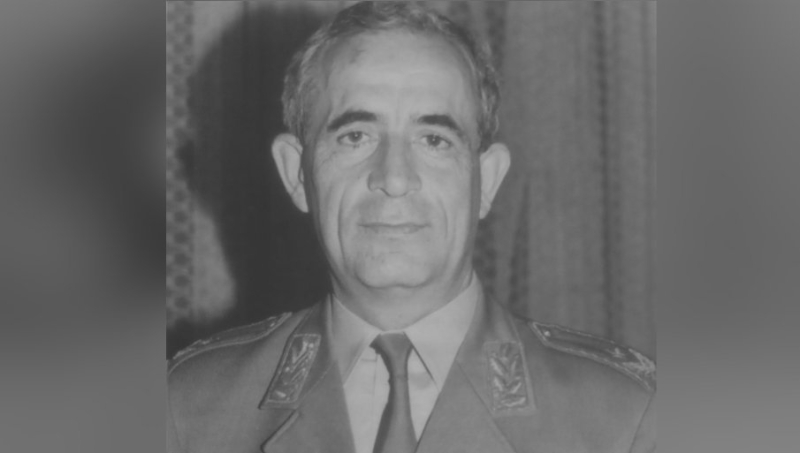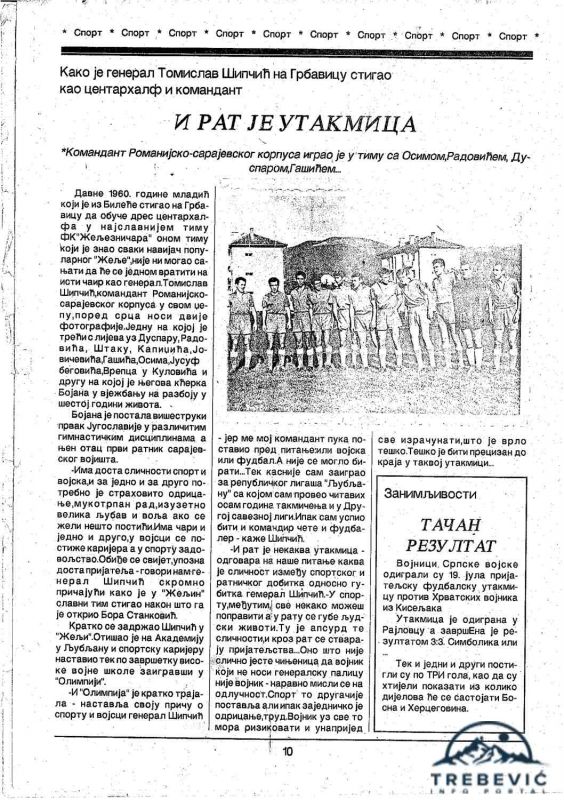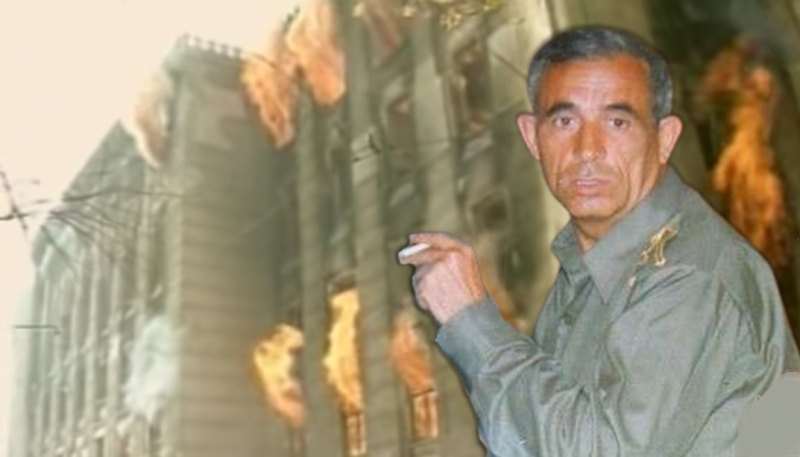Written by: Zilha Mastalić-Košuta/Stav.ba
In the period from April to mid-May 1992, Commander Vojislav Đurđevac was at the head of the Fourth Corps of the 2nd Military District of the JNA, better known as the Sarajevo Corps. It is not possible to determine exactly when he was in this position, but there is information that between May 12 and 20, 1992, he was succeeded in that position by Colonel Tomislav Šipčić.
Đurđevac is known for the fact that, as one of the main commanders of the siege of Sarajevo and as a general of the former JNA, on May 2, 1992, on the day of the general attack on Sarajevo, he captured the President of the Presidency of Bosnia and Herzegovina, Alija Izetbegović, at Sarajevo Airport, after Izetbegović's return from negotiations in Lisbon.
In the period when Šipčić commanded the Sarajevo Corps, the first minors were killed in Sarajevo. In April 1992, children were killed: Aida Zelić, Nadir Skikić, baby Belma Ćutuk, Midhat Zornić, Amir Klico, and in early May, Aida Kučuk, Armin Ćosić, Nina Dedović, Zuhra Lingo. These crimes were mostly carried out by shelling and infantry weapons, and one baby died due to a power outage in the incubator caused by shelling.
No one was convicted for the murders of these children and other crimes committed during that period. Đurđevac died in 2004 in Ljubljana. He was at the head of the corps during the period when the JNA units were making the final ring and regrouping and deploying their forces around Sarajevo. During this period, preparations were also made for the transformation of JNA units into the Sarajevo-Romanian Corps (SRK) of the Army of the Serbian Republic of Bosnia and Herzegovina, from August 1992, into the Army of the Rs (VRs).
Between May 12 and 20, 1992, the SRK VSr RBiH was formed, at the head of which Tomislav Šipčić was appointed in those days. In the Serbian daily newspaper "Politika" from July 16, 1992 and on the television "Srna" the text was published: General Šipčić: THEY THROW SERBIAN CHILDREN TO THE LIONS, in which he accused "Muslim forces of throwing Serbian children to the lions in the Sarajevo zoo". Šipčić informed the UNPROFOR Chief of Staff Lewis MacKenzie about this by telegram.
The telegram also states that "Muslim forces have formed a concentration camp for Serbs in Pionirska dolina near the zoo", and Šipčić called on MacKenzie to do everything to "stop the abuse and brutal killing of Serbs".

Šipčić, a colonel of the JNA, i.e. the Army of Yugoslavia (VJ), and since May 1992, a general of the SRK VSr RBiH, issued orders that resulted in the execution of crimes against the inhabitants of Sarajevo, among which more than 130 children were killed. He remained in that position until September 10, 1992, when Stanislav Galić took over the command.
In the period between May 12 and 20, 1992, children Murat Ušanović, Aldina Cviko, Ekrem Hamzabegović, Sanela Hasković, Armin Muminović, Jasmina Prguda, Belma Hubijar were killed. Most of these children were killed by shelling. The youngest victim was three-year-old Aldina Cviko.
Between May 21 and September 10, 1992, at least 131 children were killed. Of that number, 117 children were killed by a grenade. The youngest victims were three babies killed on 26/27. in May 1992 in the shelling of the maternity hospital; then one-year-old Amar Bibić and three-year-old Damir Mekić, killed together in the house on May 16, when three more members of their family were killed; one-year-old Amil Briga, killed on August 2 together with his grandmother; one-and-a-half-year-old Armin Dudić, killed by a grenade on June 22, when his brother was also wounded; three-year-old Zlata Kurtović was killed by a grenade on June 1, together with the girl Amela Fočo and their mothers.
The youngest victims are one-year-old Roki Sulejmanović and three-year-old Vedrana Glavaš, who were killed on August 1 while being taken out of the city by convoy. Three-year-old Mirza Hožbo and his sister Mirela were killed on August 25. A grenade was fired at their building, the apartment caught fire and, in addition to their brother and sister, their grandfather, aunt and neighbor were also burned.
The youngest victims are newborn Edin Karaman, baby Ferik Musa, three-year-old Edis Šemović, killed together with his father, a neighbor, and his mother wounded; two-year-old Benjamin Tabaković, killed together with his sister Belma, baby Šojko NN, baby Benjamin Termiz, one-year-old Saša Vlačić, as well as other children.
In the order of the Command of the SRK dated June 7, 1992, signed by Tomislav Šipčić, it is stated that the SRK has the task of clearing the parts of Sarajevo with a majority Serb population by means of a suitable grouping of forces, if possible cutting the city in the direction: Nedžarići - Stup - Rajlovac, provide a wider area of the Sarajevo airport, carry out cleaning of Mojmil, Dobrinja, Butmir and Sokolović Colony. While Šipčić ordered the "cleansing of parts of Sarajevo", a crime against the Bojadži family took place during that period, on June 9, when three minor family members, Amina, Fehim and Mirza, were killed.
Nermina Kurtović was also killed by grenades fired from SRK positions on June 8, and Admir Prašević on the same day. Emir Fazlagić was killed on June 10, when his mother was also wounded. On the same day, Mirnesa Zuko was killed by a grenade in the water line. Two days later, so did Edin Selimović.

Children were killed in various ways: on the street, at school, in a shelter, in a house or apartment, in the yard, at play, in lines for water and food, during sports activities and events, while riding a bicycle, during a truce. Convoys with babies, maternity hospitals, and a pediatric hospital were also targeted. Hospitals and maternity hospitals were constantly the target of attacks. The goal of destroying the Maternity Hospital and the Children's Clinic was to stop reproduction so that the city without children and life would be unlivable.
The destruction of hospitals is also evidenced by the statement of the Minister of Health in the self-proclaimed Serbian Republic of BiH, Dragan Kalinić, at the 16th session of the Assembly on May 12, 1992 in Banja Luka, in which he says: "(...) But those who plan the operation of Sarajevo, the liberation of Sarajevo or the destruction the enemy forces living in Sarajevo have to plan what to do with the health facilities. And let me tell you right away, if the Military Hospital falls into the hands of the enemy, then I am in favor of destroying the Koševska Hospital and leaving the enemy nowhere to be treated."
During this period, children were also killed by snipers. The snipers of SRK VRs did not choose whether it was a child, a woman or an elderly person. Their intention was clear – that every shot they fired would kill or seriously injure the person they were targeting. Special training sessions were organized for snipers at Jahorina and the training ground above Crveni stijene. The largest number of killed children were shot in the head and around the heart by a sniper, which is a clear indication of intent. The defense in the proceedings against Stanislav Galić before the ICTY claimed that the SRK VRs had no snipers.
Among the children who were killed by a sniper in the period from April to September 1992 were Amar Vuk, killed while sleeping and shot in the head, Selma Bjelak shot in the neck, Kemal Ligata, shot in the eye while holding a slice of bread in his hand and hiding. in one passage, Adisa Ramić, shot in the neck, Muamer Smajlović and others.
In this period, incendiary and chemical weapons (phosphorus bombs, aerial bombs, artillery shells with chemical weapons) prohibited by the Geneva Conventions and other provisions of international law were used. It was used in setting fire to numerous buildings in Sarajevo. Chemical weapons were used in the narrower and wider area of Sarajevo. Cultural heritage was destroyed with these weapons, which is a violation of the international law of war and can be prosecuted as a war crime.
According to the ICTY statute, these crimes include the seizure, destruction, intentional damage done to institutions of a religious, educational, scientific nature, including historical monuments and works of art. In this period, many cultural and historical monuments were destroyed. Killing children kills and destroys the family, and thus the society as a whole, and leaves lasting consequences on the entire Bosnian society.
The aggressor knew this very well.
On the other hand, by destroying the Presidency, the University of Sarajevo, the maternity hospital, the Children's Clinic, the hospital, the National and University Libraries, the Oriental Institute and all other cultural, religious and historical buildings, Bosnian roots and centuries-old culture and tradition are being erased, all with the aim of completely it erases the Bosnian past and identity.
At least 147 children were killed in Sarajevo between April and September 11, 1992. Children were killed in various ways and the most serious crimes were committed against them. To date, those responsible for these crimes have not been prosecuted. In addition to the command staff, members of the lower military staff who are also responsible for the crimes have not been convicted of crimes.
On January 31, 2011, the Institute for Research of Crimes Against Humanity and International Law of the University of Sarajevo, in cooperation with the Association of Parents of Murdered Children of Sarajevo, submitted a criminal complaint against Tomislav Šipčić to the Prosecutor's Office of Bosnia and Herzegovina. For years after that, the Prosecutor's Office of Bosnia and Herzegovina did nothing.
On April 5, 2022, the Institute was sent a letter from the Prosecutor's Office of Bosnia and Herzegovina signed by prosecutor Vesna Ilić, in which the same documentation that was sent back in 2011 is again requested. And at the request of the ICTY, which submitted documentation to the Prosecutor's Office for the Šipčić case, in which they stated that the case was urgent, the Prosecutor's Office turned a deaf ear. Last month, on July 9, 2022, Tomislav Šipčić died in Vrbas, Serbia, at the age of 83.
